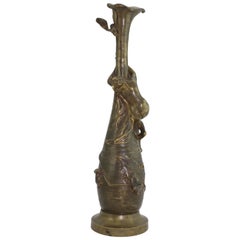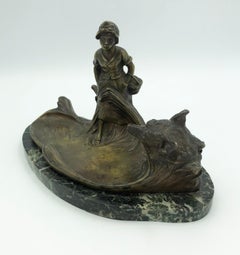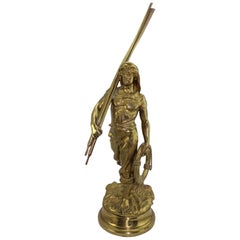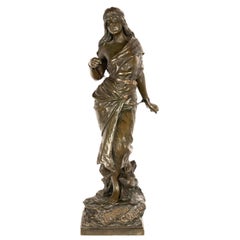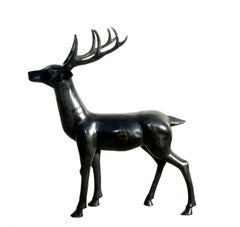Antoine Bofill Art
Spanish, 1875-1939
Antoine Bofill was born in Barcelona in 1875. He studied at the Fine Art Academy in Barcelona. He exhibited in Spain, Germany and Austria as well as in France. Bofill started exhibiting at the Paris Salon from 1894 and in 1902, he was awarded an honorable mention.
to
2
1
Overall Width
to
Overall Height
to
3
2
1
3
3
2
2
1
1
1
1
3
3
8
9,989
2,754
1,377
1,375
3
Artist: Antoine Bofill
Antoine Bofill Art Nouveau Nude Bronze Sculpture, circa 1900
By Antoine Bofill
Located in Dallas, TX
This is one of Antoine Bofill's best models, being a signature Art Nouveau nature form with a beautiful nude nymph gazing upon a bumble bee insect. The patina on this statue figure i...
Category
Early 1900s Art Nouveau Antoine Bofill Art
Materials
Bronze
Little Red Riding Hood Inkwell
By Antoine Bofill
Located in Missouri, MO
Antoine Bofill
"Little Red Riding Hood"
Bronze Inkwell
6H x 10W x 6D
Signed
Inscribed: 25 Septembre 1920
Antoine Bofill was born in Barcelona i...
Category
1920s Realist Antoine Bofill Art
Materials
Bronze
Antoine Bofill Bronze of a Sea Man with Oars, French, circa 1900
By Antoine Bofill
Located in Dallas, TX
This larger than life gold gilded bronze of a sea man with oars will decorate any area and be a great conversation piece. The composition and casting detail are amazing. This is the ...
Category
Early 1900s Art Nouveau Antoine Bofill Art
Materials
Bronze
Related Items
Antique French Art Nouveau Bronze Figure Statue Sculpture "Prise de Corsaire"
By Emmanuel Villanis
Located in Portland, OR
A fine antique large French Art Nouveau Bronze Figural Sculpture, titled "Prise de Corsaire" by Emmanuel Villanis (1858-1914), circa 1900.
This very...
Category
Early 1900s Art Nouveau Antoine Bofill Art
Materials
Bronze
$6,200
H 34 in W 11 in D 7.75 in
Deer, Large Patinated Bronze Sculpture
Located in Long Island City, NY
This bronze sculpture of a deer is a realistic rendering of the majestic animal. Deer have been the center of literature and art for many cultures across the world. They have also ...
Category
20th Century Realist Antoine Bofill Art
Materials
Bronze
Leda and the Swan
Located in West Hollywood, CA
Presenting a magnificent early Art Nouveau bronze by Belgian artist Jef Lambeaux(1852-1908.)
“Leda and the Swan”, is an original Art Nouveau Bronze,...
Category
1880s Art Nouveau Antoine Bofill Art
Materials
Bronze
Antique Horse Bronze Trotting Stallion Isidore Jules Bonheur (France, 1827-1901)
By Isidore Jules Bonheur
Located in SANTA FE, NM
Antique Horse Bronze
Portrait of a Trotting Stallion
Isidore Jules Bonheur (France, 1827-1901)
Cast bronze mounted on a rectangular plinth with dark brown patina,
Signed: I. BONHEUR
17 x 11 3/4
A brilliant exploration of a stallion in full trot. The patina is a deep, warm walnut brown with honey-colored tones.
Isidore Bonheur was best known and the most distinguished of the 19th century French animalier sculptors. Isidore, the younger brother of Rosa Bonheur and older brother of Auguste, began his studies of painting initially with his father, who was friends with Francisco Goya. By 1848 he debuted at the Paris Salon having discontinued animal and landscape painting to concentrate on creating sculptures and in 1849, Bonheur enrolled at the Ecole des Beaux Arts. He won medals at the Paris Salon in 1859 and did so again in 1865 and in 1869. After entering the Exposition Universelle 1855, he won the Gold Medal in 1889. In the 1870s exhibited in the London at the Royal Academy of Arts where he earned great prestige and won the coveted Medaille d’Or. After winning numerous other medals and prizes, Bonheur was awarded the Legion d' Honneur in 1895 and he was Knighted in Portugal, Spain and France. Bonheur continued exhibiting at the Paris Salon until 1899.
Many of his bronzes were fabricated at the foundry owned by Hippolyte Peyrol, Bonheur's brother-in-law by marriage to Isidore’s youngest sister Juliette Bonheur. The Peyrol casts for both Rosa and Isidore are exceptionally well executed which suggests a strong working relationship between the founder and sculptor. There is little doubt that Isidore Bonheur was an acute observer of nature; his animals were not anthropomorphized but modelled to catch movement or posture characteristics of the particular species he was sculpting. He achieved this most successfully with his sculptures of horses which are usually depicted as relaxed rather than spirited. These figures are among his most renowned works and his equestrian models became very popular, particularly among the British aristocracy.
An acute observer of nature, his sculptures reflect his commitment to the Realist school - with precise detailing of the movements of animals in their natural habitats. Ultimately, His naturalistic studies of animals are now some of the most highly sought after works by any of the animalier. He was possibly inspired by his many visits to the Buffalo Bill Wild West Show...
Category
1870s Realist Antoine Bofill Art
Materials
Bronze
$11,000
H 11.75 in W 17 in D 5 in
"Mother and Child" Art Nouveau Bronze Sculpture Woman Carrying Harvest Green
By Louis Auguste Moreau
Located in Austin, TX
20 inches tall x 11 inches wide at base.
Signed.
Numbered 6/100
A cast bronze sculpture that depicts an adult female, rural worker, mid-stride, holding a large bundle of wood on her...
Category
Early 20th Century Art Nouveau Antoine Bofill Art
Materials
Marble, Bronze
$1,000
H 20 in W 11 in D 11 in
Pandora's Secret
Located in PARIS, FR
Pandora's Secret
by Maurice BOUVAL (1863-1916)
Sculpture made in bronze with a nuanced dual patina, light –and dark brown
signed on the base " M. Bouval "
old edition cast
presente...
Category
Early 1900s Art Nouveau Antoine Bofill Art
Materials
Bronze
German shepherd dog by Thomas Franois Cartier 20 20th century
Located in Berlin, DE
Bronze
signed
58x 56 cm
Thomas François Cartier, born February 21, 1879 in Marseille and died April 26, 1936 in Saint-Vallier, is an animal sculptor and French illustration.
biogr...
Category
20th Century Jugendstil Antoine Bofill Art
Materials
Bronze
$4,573
H 22.84 in W 21.26 in D 8.27 in
Antique Bronze Portrait Draft Horse by Isidore Jules Bonheur (France, 1827-1901)
By Isidore Jules Bonheur
Located in SANTA FE, NM
Antique Bronze Portrait of a Draft Horse
Isidore Jules Bonheur (France, 1827-1901)
Circa 1840s
Cast bronze mounted on a rectangular plinth atop a marble s...
Category
1870s Realist Antoine Bofill Art
Materials
Bronze
$12,500
H 11.75 in W 17 in D 5 in
Sculpture, "Icarus Ascending"
Located in San Diego, CA
This is a limited edition figurative realistic sculpture by San Diego artist, Peter Dingli. It is made of bronze. Its dimensions are 21" x 35" x 15". A certificate of authenticity wi...
Category
2010s Realist Antoine Bofill Art
Materials
Metal, Bronze
La cruche cassée
Located in Mc Lean, VA
Nice, 19th-century gilt bronze cast by Emile Francois Carlier
Exhibited:
Salon, Société des Artistes Français, Paris, 1865 (another cast)
Salon, Société des Artistes Français, Pari...
Category
Late 19th Century Realist Antoine Bofill Art
Materials
Bronze
Antique Orientalist Arab Slave Trader Female Nude Group Cold Painted Bronze 1910
By Franz Bergmann
Located in Portland, OR
A very large 24" (61cm) Franz Xavier Bergmann (1861-1936) cold painted bronze group statue, signed, Austria, circa 1910.
The bronze in the Orientalist manner & depicts a young slave ...
Category
1910s Art Nouveau Antoine Bofill Art
Materials
Bronze
Franz BergmannAntique Orientalist Arab Slave Trader Female Nude Group Cold Painted Bronze 1910, 1910
$4,500
H 28 in W 11.75 in D 12 in
Bronze Hippopotame
By Sophie Martin
Located in Pasadena, CA
Animal sculptor Sophie MARTIN creates from inert clay a whole living animal kingdom.
She freely observes the animal and captures and interprets a movement; and places it in nature a...
Category
21st Century and Contemporary Realist Antoine Bofill Art
Materials
Bronze
Antoine Bofill art for sale on 1stDibs.
Find a wide variety of authentic Antoine Bofill art available for sale on 1stDibs. You can also browse by medium to find art by Antoine Bofill in bronze, metal and more. Not every interior allows for large Antoine Bofill art, so small editions measuring 10 inches across are available. Customers who are interested in this artist might also find the work of Gary Alsum, SOPHIE MARTIN, and Gary Sczerbaniewicz. Antoine Bofill art prices can differ depending upon medium, time period and other attributes. On 1stDibs, the price for these items starts at $3,800 and tops out at $3,800, while the average work can sell for $3,800.
